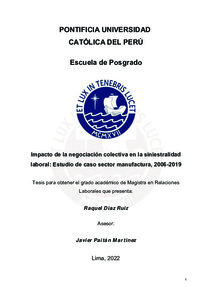| dc.contributor.advisor | Paitán Martínez, Javier | |
| dc.contributor.author | Diaz Ruiz, Raquel | |
| dc.date.accessioned | 2022-10-14T19:48:08Z | |
| dc.date.available | 2022-10-14T19:48:08Z | |
| dc.date.created | 2022 | |
| dc.date.issued | 2022-10-14 | |
| dc.identifier.uri | http://hdl.handle.net/20.500.12404/23569 | |
| dc.description.abstract | La presente investigación busca describir y analizar el comportamiento de la
siniestralidad laboral como resultado de la negociación colectiva, siendo esta
última una herramienta para la prevención de riesgos laborales, en la medida tiene
como objeto la determinación de las condiciones de trabajo, las cuales forman
parte de los riesgos psicosociales en seguridad y salud en el trabajo. Se centra
en el sector de manufactura y en el estudio de caso de una empresa de este sector
entre los años 2006 y 2019.
Se aplica la metodología que nos permite integrar los enfoques cualitativos y
cuantitativos. Consiste en el análisis de entrevistas semiestructuradas realizadas
a los actores en la negociación colectiva y el análisis de la información cuantitativa
sobre la negociación colectiva y seguridad y salud en el trabajo de diferentes
bases de datos nacionales y/o internacionales, así como el análisis de la aplicación
de cuestionario CoPsoQ-Istas 21. Este último es una herramienta que permite
identificar y medir aquellas características de la organización del trabajo como
factores de riesgo psicosocial.
La investigación es oportuna y pertinente ante las elevadas cifras de accidentes
laborales a nivel mundial y Perú, y la preocupación al respecto en todos los niveles
de las relaciones laborales que son; la necesidad del Estado de adecuar la
legislación nacional y la reducción de las cifras de siniestralidad laboral por parte
de las empresas en cuanto a responsabilidades en caso de accidentes, y del
propio colectivo de trabajadores.
El resultado de la investigación visibiliza la oportunidad de disminuir el número de
accidentes laborales a través de la inclusión de cláusulas referentes a la
adecuación de las condiciones de trabajo y que desde los sindicatos se reoriente
a abandonar la monitorización del riesgo laboral, y dirigir la negociación colectiva
hacia la prevención y minimización de los riesgos y adecuación de los puestos de
trabajo. | es_ES |
| dc.description.abstract | This research seeks to describe and analyze the behavior of the occupational
accident rate as a result of collective bargaining, the latter being a tool for the
prevention of occupational risks, to the extent that it has as a purpose the
determining of the working conditions, which are part of the psychosocial risks in
safety and health at work. It focuses on the industry manufacturing and studies the
case of a company in this sector between the years 2006 and 2019.
A methodology applied, which allows us to integrate the qualitative and quantitative
approaches. It consists on the analysis of semi-structured interviews conducted
with the actors in collective bargaining, and the analysis of quantitative information
on the collective bargaining and occupational health and safety from different
databases national and/or international, as well as the analysis of the questionnaire
application CoPsoQ-Istas 21. The latter is a tool that allows identifying and
measuring those characteristics of work organization as psychosocial risk factors.
The investigation is appropriate and pertinent given the high number of accidents
at the world level and in Peru, and the existing concern in this regard at all levels
of labor relations, the need for the State to adapt the national legislation and the
reduction of the figures of labor accidents in the companies in terms of
responsibilities in the event of accidents, and also in the workers ‘collective itself.
The result of the investigation makes visible the opportunity to reduce the number
of occupational accidents through the inclusion of clauses referring to the
adequacy of working conditions, and shows the need for the Trade Unions to
reorient it to the abandon of occupational risk monitoring, and direct collective
bargaining towards the prevention and minimization of risks and adaptation of jobs. | es_ES |
| dc.language.iso | spa | es_ES |
| dc.publisher | Pontificia Universidad Católica del Perú | es_ES |
| dc.rights | info:eu-repo/semantics/openAccess | es_ES |
| dc.rights.uri | http://creativecommons.org/licenses/by/2.5/pe/ | * |
| dc.subject | Seguridad industrial--Perú | es_ES |
| dc.subject | Negociación colectiva--Perú | es_ES |
| dc.title | Impacto de la negociación colectiva en la siniestralidad laboral: Estudio de caso sector manufactura, 2006-2019 | es_ES |
| dc.type | info:eu-repo/semantics/masterThesis | es_ES |
| thesis.degree.name | Magíster en Relaciones Laborales | es_ES |
| thesis.degree.level | Maestría | es_ES |
| thesis.degree.grantor | Pontificia Universidad Católica del Perú. Escuela de Posgrado | es_ES |
| thesis.degree.discipline | Relaciones Laborales | es_ES |
| renati.advisor.dni | 45829910 | |
| renati.advisor.orcid | https://orcid.org/0000-0003-1638-3969 | es_ES |
| renati.author.dni | 00248020 | |
| renati.discipline | 418297 | es_ES |
| renati.juror | Solis Vargas, Olga Rocio | es_ES |
| renati.juror | Paitán Martinez, Javier | es_ES |
| renati.juror | Dagnino Varas, Fernando Ernesto | es_ES |
| renati.level | https://purl.org/pe-repo/renati/level#maestro | es_ES |
| renati.type | https://purl.org/pe-repo/renati/type#tesis | es_ES |
| dc.publisher.country | PE | es_ES |
| dc.subject.ocde | https://purl.org/pe-repo/ocde/ford#5.09.00 | es_ES |






